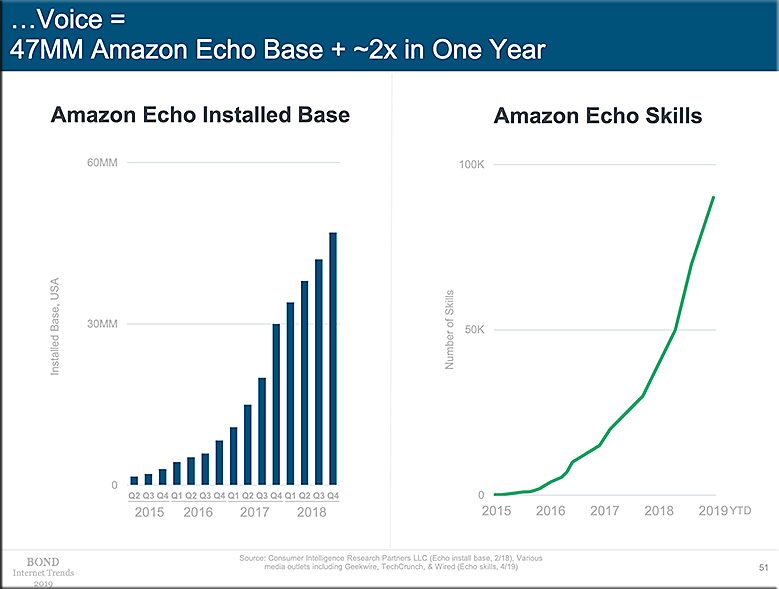Excerpts:



From DSC:
That last one reminded me of why I think the Living from the Living [Class] Room vision is so powerful…
8 industrial IoT trends of 2019 that cannot be ignored — from datafloq.com
Excerpt:
From manufacturing to the retail sector, the infinite applications of the industrial internet of things are disrupting business processes, thereby improving operational efficiency and business competitiveness. The trend of employing IoT-powered systems for supply chain management, smart monitoring, remote diagnosis, production integration, inventory management, and predictive maintenance is catching up as companies take bold steps to address a myriad of business problems.
No wonder, the global technology spend on IoT is expected to reach USD 1.2 trillion by 2022. The growth of this segment will be driven by firms deploying IIoT solutions and giant tech organizations who are developing these innovative solutions.
To help you stay ahead of the curve, we have enlisted a few trends that will dominate the industrial IoT sphere.
5. 5G Will Drive Real-Time IIoT Applications
5G deployments are digitizing the industrial domain and changing the way enterprises manage their business operations. Industries, namely transportation, manufacturing, healthcare, energy and utilities, agriculture, retail, media, and financial services will benefit from the low latency and high data transfer speed of 5G mobile networks.
Virtual reality helping those with developmental disabilities — from kivitv.com by Matt Sizemore
How VR is making autistic individuals more independent
Excerpts:
EAGLE, IDAHO — If you think modern day virtual reality is just for gaming, think again. New technology is helping those with developmental disabilities do more than ever before, and much of that can be found right in their own backyard.
…
“I see unlimited potential inside of their minds. I see us being able to unlock a certain person who can achieve things that we never thought could be done, and all of this could happen off of just exposing them to virtual reality,” said Smythe.
VR1 and the Autism XR Institute are constantly creating tools and ideas to help kids and adults with autism live a more independent life through virtual reality.
Also see:
Making a final wish comes true: Hospice expanding virtual reality therapy — from galioninquirer.com by Russell Kent
Excerpt:
ASHLAND — Hospice of North Central Ohio is extending its virtual reality therapy (VRT) in an effort to help Richland County hospice and palliative patients fulfill their last wishes, thanks to a $7,000 grant from the Robert and Esther Black Family Foundation Fund of The Richland County Foundation.
VRT uses video technology to generate realistic 360-degree, photographic or animated three-dimensional images, accompanied by sounds from the actual environment. When donning the headset and headphones, viewers are surrounded by visuals and sounds that give the impression of being physically present in the environment. Virtual reality therapy treatment allows patients to relive memories, return to places of emotional significance, or experience something or somewhere that they desire.
How the internet of things will change your life — from uk.rs-online.com
‘Internet of Things’ is transforming health care, Geneia president says — from unionleader.com by Kim Haas
What are the issues with Fog Computing? — from yourtechdiet.com by Brian Curtis
Advantages:
• It reduces the amount of data transferred to the cloud by having an edge location.
• Supports mobility and improves system response time.
• It minimizes network latency and conserves network bandwidth.
• Data can be processed with no bandwidth availability.
• Acts like an intermediate b/w IOT devices and Cloud computing infrastructure.
Disadvantages:
• It has some wireless security issues and privacy concerns.
• Authentication issues and trusted certificates concern
Fog computing helps in building some of the Smart Hi-Tech Cities, Buildings, Vehicle networks and Software Defined Networks (SDN).
Smart building complexity is creating dangerous new hacking opportunities — from techradar.com by Ian Heritage
Complex IoT environments can spell bad news for IT professionals
How 5G will fast track the internet of things — from .inkstonenews.com by Zheping Huang
Excerpt:
In Hangzhou, police officers are notified of major car accidents soon after they happen, traffic lights automatically adjust to changes in the volume of vehicles on the road and, in emergencies, fire trucks and ambulances are not stopped by a single red light until they arrive at the scene.
The city in eastern China’s Zhejiang province is one of the country’s major tech hubs. Its smart infrastructure powers the City Brain project, a cloud computing and AI-driven urban traffic-management system. It covers a total area of 162 square miles – that’s seven times the size of Manhattan.
When 5G mobile services start to roll out worldwide next year, smart cities such as Hangzhou will get even smarter as next-generation wireless technology helps industries realize the full potential of the internet of things (IoT).
“5G, from the beginning of its infrastructure design, has the internet of things in mind,” said Cui Kai, a Beijing-based IoT analyst with research firm International Data Corporation (IDC).
The stakes are high for industries around the world, as global spending on IoT is forecast to exceed $1 trillion in 2022, up from an estimated $745 billion this year, according to IDC.
With peak data rates up to 20 times faster than 4G, 5G will serve as “the connective tissue” for IoT, autonomous cars, smart cities and new mobile applications – providing the backbone for the industrial internet, according to a Deloitte report.
How the Internet of Things (IoT) can change the face of your business — from yourtechdiet.com by Brian Curtis
What is an IoT platform?
IOT platform is the support software which connects hardware, data networks and access points to other parts, i.e. to end-user application. Moreover, the IOT platform helps to automate their environment. So you can consider it as a middleware solution between data and the user.
…
Here are the five reasons why your business needs IoT.
Lawmakers want to stop a future filled with smart devices and bad security — from cnet.com by Alfred Ng
“Unsecured IoT devices will be like the new asbestos.”
Excerpts:
Before smart devices fill up millions of homes, a Senate hearing on Tuesday looked to figure out how to keep them safe from hackers.
“Sound security practices must keep pace with the expansion of the internet of things in order to mitigate these threats,” Sen. Dan Sullivan said in his opening statement. Sullivan, a Republican from Alaska, is chairman of the commerce committee’s subcommittee on security.
…
“While IoT holds a promise of revolutionizing the way we live and we work, we should also be wary, because IoT also stands for the internet of threats,” said Sen. Ed Markey, a Democrat from Massachusetts.
“Unsecured IoT devices will be like the new asbestos,” Geiger said. “We will build them into our environments, only to have to rip them back out years later, and wonder why our predecessors did not have the forethought to ensure basic security from the start.”